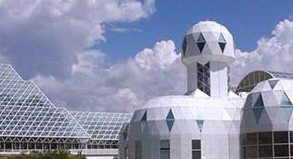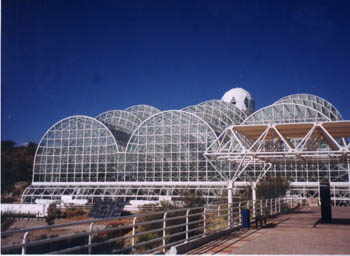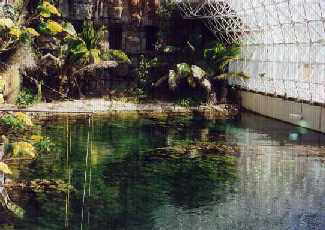
Melbourne Australia
Schools For a Sustainable Future

Story
about econews
sample ad
school entry form
school flier
sponsors join on-line
sponsors & prizes
Why we should worry about orang-utans
It's sheer hubris to assume
we'll survive a world that sends other species into extinction.

Claire Miller
Environmental Reporter
Reprinted courtesy of The AGE
``DOOMED: the last apes of Borneo.'' The front-page headline in last Saturday's Age was cause for pause over the morning muesli. What would it mean, a world without orang-utans in the wild? Maybe not that much, since most people will never see them at home in the rainforest.
In an abstract kind of way, we like to know they are there and would grieve their passing, but, like the loss of someone admired from afar but not known personally, it is hard to imagine their absence changing our lives in any material sense. The same goes for spot-tailed quolls, pandas, Siberian tigers - any one of thousands of lovely but seemingly doomed creatures.
If only extinction was no more than a matter of regret.
The problem with a world without orang-utans is that it is also a world without the complex habitat that sustains them. Everywhere, habitats are being cleared and replaced by agriculture or weedy regrowth. Both are simplified ecosystems functioning with a fraction of the original biodiversity. And simplified ecosystems have a habit of behaving in unpredictable ways.
 This
was brought home powerfully in a $200million experiment in the Arizona
desert almost a decade ago, when eight people were sealed in a giant,
self-contained bubble called Biosphere II.
This
was brought home powerfully in a $200million experiment in the Arizona
desert almost a decade ago, when eight people were sealed in a giant,
self-contained bubble called Biosphere II.
Biosphere II was designed to simulate the natural systems that sustain human life on Biosphere I - the Earth. And so almost 4000 carefully selected plants and creatures were assembled to create four simplified ecosystems: a desert, a tiny ocean, a grassland and a tropical forest.
 In
theory, Biosphere II was a self-sustaining little world capable of keeping
its eight ``bionauts'' alive and in good health for two years by generating
and purifying water, recycling wastes, producing oxygen, absorbing carbon
dioxide, capturing sunlight through photosynthesis and growing plants
for food.
In
theory, Biosphere II was a self-sustaining little world capable of keeping
its eight ``bionauts'' alive and in good health for two years by generating
and purifying water, recycling wastes, producing oxygen, absorbing carbon
dioxide, capturing sunlight through photosynthesis and growing plants
for food.
The experiment failed.
First, oxygen levels plummeted. Then nitrogen levels rocketed. The insects supposed to pollinate the plants could not survive under these conditions and died, depriving the bionauts of food. Meanwhile the cockroaches, katydids and crazy ants went, well, crazy. So did some plants and vines. The bionauts exhausted themselves hacking back the vegetation and fighting the rogue insects.
Eventually they gave up
and came out early, sick and defeated.
Biosphere II is a warning against
hubris at a time when biodiversity is collapsing worldwide.
Firstly, we are not in a position to pick and choose which species we think we cannot do without; we don't know enough about the intricate workings of natural systems to make those judgments.
 Secondly,
Biosphere II proved that simplified ecosystems can change the basic conditions
for life; life still exists but the new conditions might not be especially
conducive to human wellbeing.
Secondly,
Biosphere II proved that simplified ecosystems can change the basic conditions
for life; life still exists but the new conditions might not be especially
conducive to human wellbeing.
There are thought to be between 10million and 30million species on the planet, of which humans have identified 1.8million. The fossil record suggests a background rate of extinction of two to six species a year; this translates to roughly one mammal and two birds every 400 years.
However, the World Conservation Union estimates species are now disappearing at 1000-10,000 times the background rate due to human activities. It is death by a thousand cuts - from pollution; competition from exotic species spread by global human travel; over-exploitation for food, body parts and recreational hunting; climate change; and, most serious of all, the loss and fragmentation of habitat as cities expand and land is logged or cleared.
Dr Peter Raven, of US President Bill Clinton's scientific advisory committee, told a 1998 CSIRO symposium that at this rate 25per cent of species will be history by 2025 and 75per cent by 2100.
In Australia, we can see in the salinity crisis how biodiversity loss changes basic conditions. The salinity is caused by clearing diverse native vegetation adapted to local conditions and replacing it with simplified ecosystems of (mostly) exotic species suitable for grazing and cropping. This has altered the hydrological balance, bringing salty water tables to the surface. Salt-tolerant reeds are flourishing under these conditions, but the outlook is not good for the food plants we rely on to eat and earn export income.
A simplified ecosystem is also less resilient. It has less flexibility to withstand and adapt to the shocks of disease and changes in climate and chemical composition. In 1999, a toxic algal bloom poisoned the Gippsland Lakes for six weeks. Artificial fertilisers, pesticides and herbicides washing off farms and accumulating over years created the perfect conditions for this one form of life to flourish at the expense of all others - fish, humans, birds, livestock.
It takes time for ecosystems to recover from such shocks, but worldwide they are occurring more and more often. Many systems are considered to be weakened almost to the point of no return.
At every turn, humans are causing changes in environmental functions that are not conducive to human wellbeing. We are in effect conducting a global experiment along the lines of Biosphere II - in anything but a controlled environment.
From this perspective, biodiversity conservation becomes less a matter of saving the cute and cuddly than of saving ourselves. Looking again at the sad eyes of the baby orang-utans of Borneo, I saw only pity.
Claire Miller is The Age's environment reporter
The Age Publication
16 November 2000
SFSF
Schools For a Sustainable Future
1 Curdies St.
E. Bentleigh Vic. 3165
Email:
Joe Natoli
Ph: (03) 9579-7224 Fax:
(03) 9579-6153 Mobile: 0411-568-523